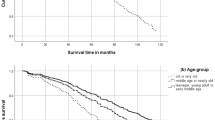Abstract
In a previous field-based study, how old one looks for one’s age (perceived age) was found to be predictive of mortality in elderly individuals. In conjunction, perceived age is of relevance and interest to the layperson. Here, a clinical methodology for generating perceived age as a biomarker of facial ageing is detailed. The methodology utilises facial photographs of subjects to present images to large numbers of age assessors who are primarily nationals of the country of study origin. In five observational studies in five different countries involving 874 female subjects it was found that subject age and assessor gender, nationality, age and ageing expertise had little effect on the perceived age data generated. However, increasing the numbers of age assessors up to 50 substantially increased the reproducibility of the mean perceived age for an image and a minimum of 10 assessors were required to give reproducible data. This methodology was also compared to a methodology that utilises passport-type photographs of subjects typically taken in field studies. Although the perceived age data from the two types of images were more similar to each other than to chronological age, there was a marked difference between the two sets of data. Therefore, to allow meaningful comparisons across perceived age studies, the same type of image should be used for the generation of perceived age. In conclusion, the methodology detailed here has demonstrated that perceived age can be a reproducible measure when large numbers of adult age assessors are used and can be utilised globally in studies to investigate facial ageing.

Similar content being viewed by others
References
Borkan GA, Norris AH (1980) Assessment of biological age using a profile of physical parameters. J Gerontol 35:177–184
Bulpitt CJ, Rajkumar C, Cameron JD (1999) Vascular compliance as a measure of biological age. J Am Geriatr Soc 47:657–663
Bulpitt CJ, Markowe HLJ, Shipley MJ (2001) Why do some people look older than they should? Postgrad Med J 77:578–581
Burt DM, Perrett DI (1995) Perception of age in adult caucasian male faces-computer graphic manipulation of shape and color information. Proc R Soc Lond B Biol Sci 259:137–143
Christensen K, Iachina M, Rexbye H, Tomassini C, Frederiksen H, Mcgue M, Vaupel JW (2004) “Looking old for your age”: genetics and mortality. Epidemiology 15:251–252
Fink B, Grammer K, Matts PJ (2006) Visible skin color distribution plays a role in the perception of age, attractiveness, and health in female faces. Evol Hum Behav 27:433–442
Ingelsson E, Sullivan LM, Murabito JM, Fox CS, Benjamin EJ, Polak JF, Meigs JB, Keyes MJ, O’Donnell CJ, Wang TJ, D’Agostino RB Sr, Wolf PA, Vasan RS (2007) Prevalence and prognostic impact of subclinical cardiovascular disease in individuals with the metabolic syndrome and diabetes. Diabetes 56:1718–1726
Krejci-Papa, Langdon RC (2006) In: Gilchrest BA, Krutmann J (eds) Skin aging in three dimensions. Springer-Verlag, Berlin, pp 133–142
Rexbye H, Petersen I, Iachina M, Mortensen J, Mcgue M, Vaupel JW, Christensen K (2005) Hair loss among elderly men: etiology and impact on perceived age. J Gerontol A Biol Sci Med Sci 60:1077–1082
Rexbye H, Petersen I, Johansens M, Klitkou L, Jeune B, Christensen K (2006) Influence of environmental factors on facial ageing. Age Ageing 35:110–115
Rikkert MGMO (1999) Visual estimation of biological age of elderly subjects: good interrater agreement. Gerontology 45:165–167
Seeman TE, McEwen BS, Rowe JW, Singer BH (2001) Allostatic load as a marker of cumulative biological risk: MacArthur studies of successful aging. Proc Natl Acad Sci USA 98:4770–4775
Warren R, Gartstein V, Kligman AM, Montagna W, Allendorf RA, Ridder GM (1991) Age, sunlight, and facial skin—a histologic and quantitative study. J Am Acad Dermatol 25:751–760
Yamaguchi MK, Oda M (1999) Does cardioidal strain change in real front-view facial images tend to change the perceived age? Electron Comm Jpn 82:39–48
Acknowledgements
The authors would like to acknowledge all the individuals involved from Unilever HPC Spain Madrid, Unilever Research and Development Trumbull US, Unilever Research China, and also Frans Van-der-Ouderaa, Michael Catt, Stewart Granger, Gail Jenkins, Amelia Fereday, Martin Green and Jakob Mortensen for making the work possible. The authors would also like to acknowledge the contribution of the assessors and subjects who took part in the studies.
Author information
Authors and Affiliations
Corresponding author
Supplementary material: please see the supplementary data on the journal website.
Rights and permissions
About this article
Cite this article
Gunn, D.A., Murray, P.G., Tomlin, C.C. et al. Perceived age as a biomarker of ageing: a clinical methodology. Biogerontology 9, 357–364 (2008). https://doi.org/10.1007/s10522-008-9141-y
Received:
Accepted:
Published:
Issue Date:
DOI: https://doi.org/10.1007/s10522-008-9141-y




